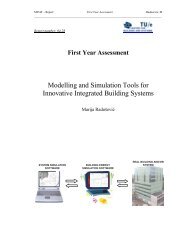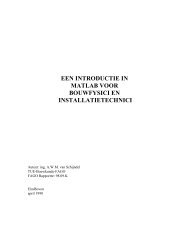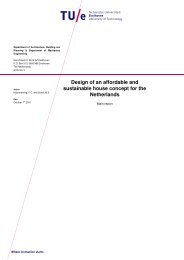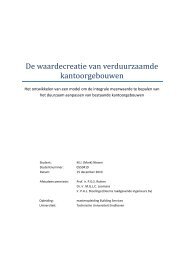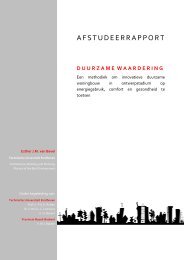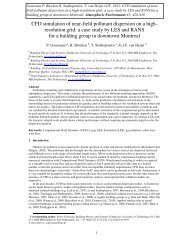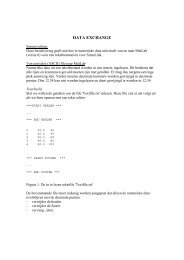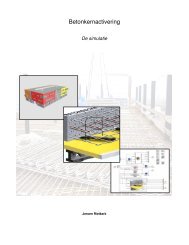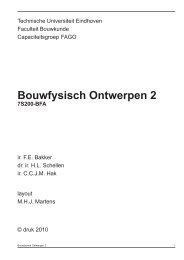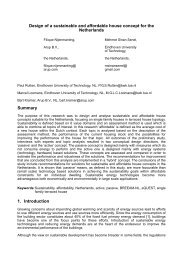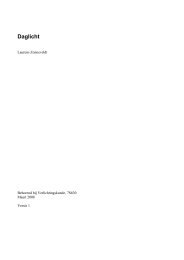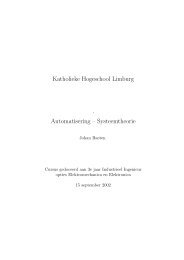Performance indicators for health, comfort and safety of the indoor ...
Performance indicators for health, comfort and safety of the indoor ...
Performance indicators for health, comfort and safety of the indoor ...
You also want an ePaper? Increase the reach of your titles
YUMPU automatically turns print PDFs into web optimized ePapers that Google loves.
Los trabajos realizados dentro del primer subgrupo toman como base la hipótesis deAcemoglu & otros (2001), según la cual, la latitud que se ubicaban los países africanosasociada a condiciones climatológicas adversas para los colonizadores europeos, fuedeterminante para que estos últimos éstos optaran por instituciones que facilitaban laextracción de recursos naturales –que perduran hasta hoy- y no aquellas generadoras devalor como las establecidas en otras regiones con latitudes similares a las del continenteeuropeo (como fue el caso de Australia, Canadá y los Estados Unidos). Así, Masanjala& Papageorgiou (2005) encuentran una relación negativa entre la tasa de crecimiento enÁfrica y la fracción que representa la minería en el PBI (una herencia de su pasadocolonial). Mk<strong>and</strong>awire & Soludo (1999) también destacan que la excesiva dependenciade las economías africanas por los ingresos de sus exportaciones, principalmentecommodities (lo que a su vez es fruto de su herencia colonial) las hace excesivamentevulnerables a los vaivenes de precios; asimismo, la región se ve frecuentementeafectada por sequías y concentra el mayor número de países sin acceso al mar. En lo quea la importancia relativa de estas condiciones se refiere, Temple (1998) encuentra quelas condiciones iniciales pueden explicar más de la mitad de la variación en las tasas decrecimiento de los países africanos.En el caso de las economías en transición, de Melo & otros (1997) advierten que laevaluación del desempeño de estas economías tendía a relacionarse sólo con laspolíticas, sin tomar en cuenta el diferente grado institucional que estos países tenían almomento de la caída del comunismo. Entre las consideraciones que estos autoresseñalan es que las condiciones iniciales pueden actuar como camisas de fuerza o biencomo catapultas para procesos de re<strong>for</strong>ma, por lo cual ello puede afectar la velocidadcon la que las políticas son implementadas; aunque el efecto de largo plazo de estascondiciones tiende a disminuir con el tiempo 1 . Estos autores encuentran que laseconomías pueden diferir en sus condiciones iniciales en varias dimensiones, pero lasque tendrían mayor influencia negativa serían la presencia de distorsiones de mercado einestabilidad macroeconómica y el grado de sobreindustrialización. En el caso particularde Rusia, Ahrend (2002) señala que el desempeño diferenciado para las regiones dedicho país durante los 90s se atribuyó a la diferente dotación de recursos naturales yhumanos, así como al distinto grado de estructura industrial, sin que la política adoptadatenga un mayor impacto. Por su parte, Godoy & Stiglitz (2006) en un estudio más actual1 Como igualmente señalan Fisher & Sahay (2004).4
Figure 1: Indicator framework <strong>for</strong> <strong>indoor</strong> air qualityCONCLUSIONS AND RECOMMENDATIONSIn this paper, <strong>the</strong> development <strong>of</strong> a building per<strong>for</strong>mance indicator framework <strong>for</strong> <strong>health</strong> <strong>and</strong>com<strong>for</strong>t has been presented. <strong>Per<strong>for</strong>mance</strong> <strong>indicators</strong> <strong>for</strong> acoustic com<strong>for</strong>t, visual com<strong>for</strong>t,<strong>indoor</strong> air quality, quality <strong>of</strong> drinking water, <strong>and</strong> <strong>the</strong>rmal com<strong>for</strong>t have been reviewed. Thestudy showed that <strong>the</strong> level <strong>of</strong> detail on which <strong>the</strong> in<strong>for</strong>mation with respect to <strong>the</strong> <strong>indicators</strong><strong>and</strong> parameters is available, is <strong>the</strong> main issue which influences <strong>the</strong> complexity <strong>of</strong> <strong>the</strong> indicatorframework. Three assessment levels have been proposed. The assessment levels correspond to<strong>the</strong> different life cycle phase <strong>of</strong> a building, i.e. design, construction, <strong>and</strong> in-use phase, where<strong>the</strong> amount <strong>of</strong> in<strong>for</strong>mation is varying. The resulting indicator framework is applicable <strong>for</strong> <strong>the</strong>assessment <strong>of</strong> <strong>the</strong> <strong>indoor</strong> environment in a building.HEALTHANDCOMFORTACCESSIBILITYSAFETYPOSITIVE STIMULATIONADAPTABILITYSERVICE LIFEUSABILITYAdaptabilityService LUsabilityAccessSafetyStimulateAcousticVisualIndoor AirD WaterThermalFigure 2: A schematic view <strong>of</strong> <strong>the</strong> conceptual frameworkHEALTHCOMFORTACCESSIBILITYSAFETYPOSITIVE STIMULATIONADAPTABILITYSERVICE LIFEUSABILITYENVIRONMENTAL SUSTAINABILITYECONOMIC SUSTAINABILITYPERFORMANCE(SOCIALSUSTAINABILITY)In a future study, <strong>the</strong> development <strong>of</strong> <strong>the</strong> indicator framework <strong>for</strong> <strong>health</strong> <strong>and</strong> com<strong>for</strong>t iscontinued <strong>and</strong> <strong>the</strong> framework is implemented in a building per<strong>for</strong>mance indicator framework
<strong>and</strong> labeling system <strong>for</strong> <strong>the</strong> assessment <strong>and</strong> evaluation <strong>of</strong> sustainable buildings. Figure 2presents a schematic view <strong>of</strong> <strong>the</strong> conceptual framework.ACKNOWLEDGEMENTSThe study presented in this paper is part <strong>of</strong> <strong>the</strong> European research project on <strong>Per<strong>for</strong>mance</strong>Indicators <strong>for</strong> Health, Com<strong>for</strong>t <strong>and</strong> Safety <strong>of</strong> <strong>the</strong> Indoor Environment (PERFECTION,www.ca-perfection.eu). The PERFECTION partners P. Huovila (VTT, Finl<strong>and</strong>), H. Järnstrom(VTT, Finl<strong>and</strong>), J. Desmyter (BBRI, Belgium), P.-H. Lefèbvre (BBRI, Belgium), A. Lupíšek(CVUT, Czech Republic) P. Hájek (CVUT, Czech Republic), J. Hodková (CVUT, CzechRepublic), S. Botsi (ApinTech Ltd., Greece), N. Sakkas (ApinTech Ltd., Greece) aregratefully acknowledged <strong>for</strong> <strong>the</strong>ir contributions.REFERENCES1. Bluyssen, P., 2009, Towards new methods <strong>and</strong> ways to create <strong>health</strong>y <strong>and</strong> com<strong>for</strong>tablebuildings. Building <strong>and</strong> Environment, 45, p. 808-818.2. CEN. prEN 15643, 2008, Sustainability <strong>of</strong> construction works - Sustainability assessment <strong>of</strong>buildings. Part 1: general framework, Part 2: framework <strong>for</strong> <strong>the</strong> assessment <strong>of</strong> environmentalper<strong>for</strong>mance. France, AFNOR; 2008.3. Loomans, M., Bluyssen, P., 2005, Final Report on Indoor Environment (Domain 2).Rotterdam, The Ne<strong>the</strong>rl<strong>and</strong>s, PeBBu Network, CIBdf - International Council <strong>for</strong> Research <strong>and</strong>Innovation in Building <strong>and</strong> Construction.4. Järnstrom H., Huovila, P. , Lupíšek, A. , Botsi, S., Hájek, P., Sakkas, N., Hodková, J.,Lefebvre, P.H., Desmyter, J., Steskens, P., Loomans, M., 2009, Indoor Indicators. Paperpresented at <strong>the</strong> Perfection Workshop, Krakow, December 2009.5. Howarth, P. A., 2005, Assessment <strong>of</strong> <strong>the</strong> visual environment, Evaluation <strong>of</strong> Human Work.6. World Health Organization (WHO), 2000, Indoor Air Quality Guidelines <strong>for</strong> Europe. ReportNo. 91.7. World Health Organization (WHO), 2005, WHO Air quality guidelines update. Report on aworking group meeting, Bonn, Germany.8. Schuh, C. K., 2000, <strong>Per<strong>for</strong>mance</strong> Indicators <strong>for</strong> Indoor Air Quality, Ph.D. Thesis, University<strong>of</strong> Calgary, Calgary, Alberta.9. ASHRAE 55-2004R, 2004, Thermal Environmental Conditions <strong>for</strong> Human Occupancy.Atlanta, GA., American Society <strong>of</strong> Heating, Refrigerating <strong>and</strong> Air-Conditioning Engineers.10. ISO 7730-2005, 2005, Ergonomics <strong>of</strong> <strong>the</strong> <strong>the</strong>rmal environment - Analytical determination <strong>and</strong>interpretation <strong>of</strong> <strong>the</strong>rmal com<strong>for</strong>t using calculation <strong>of</strong> <strong>the</strong> PMV <strong>and</strong> PPD indices <strong>and</strong> local<strong>the</strong>rmal com<strong>for</strong>t criteria. International St<strong>and</strong>ards Association, Geneva.11. Fanger, P. O., 1970, Thermal Com<strong>for</strong>t. Copenhagen, Danish Technical Press.12. Nishi, Y., Gagge, A. P., 1977, Effective temperature scale useful <strong>for</strong> hypo- <strong>and</strong> hyperbaricenvironments. Aviation, Space Med., 48, Issue 2, p. 97-107.13. Arens, E., Zhang, H., Huizenga, C., 2006, Partial- <strong>and</strong> whole-body <strong>the</strong>rmal sensation <strong>and</strong>com<strong>for</strong>t - Part I: Uni<strong>for</strong>m environmental conditions. Journal <strong>of</strong> Thermal Biology, vol. 31, no.1-2, p. 53-59.14. Arens, E., Zhang, H., Huizenga, C., 2006, Partial- <strong>and</strong> whole-body <strong>the</strong>rmal sensation <strong>and</strong>com<strong>for</strong>t - Part II: Non-uni<strong>for</strong>m environmental conditions. Journal <strong>of</strong> Thermal Biology, vol.31, no. 1-2, p. 60-6615. Nicol, J.F., Humphreys. M., 2001, Adaptive <strong>the</strong>rmal com<strong>for</strong>t <strong>and</strong> sustainable <strong>the</strong>rmalst<strong>and</strong>ards <strong>for</strong> buildings. Energy <strong>and</strong> Buildings, Vol. 34, Issue 6, pp. 563-572.16. Dear,R. de, 2009, Towards a <strong>the</strong>ory <strong>of</strong> adaptive <strong>the</strong>rmal com<strong>for</strong>t <strong>the</strong> pleasure principle.Healthy Buildings Conference <strong>and</strong> Exhibition 2009, Syracuse, New York.17. International Society <strong>of</strong> Indoor Air Quality <strong>and</strong> Climate (ISIAQ), 2003, <strong>Per<strong>for</strong>mance</strong> Criteria<strong>of</strong> Buildings <strong>for</strong> Health <strong>and</strong> Com<strong>for</strong>t. ISIAQ-CIB TG 42.
18. Cox, C. et al. 2005. Health Optimisation Protocol <strong>for</strong> Energy-efficient Buildings, Prenormative<strong>and</strong> socio-economic research to create <strong>health</strong>y <strong>and</strong> energy-efficient buildings(HOPE). Final report, TNO Indoor Environment <strong>and</strong> Geosciences, Delft, The Ne<strong>the</strong>rl<strong>and</strong>s.




